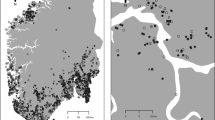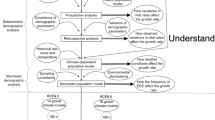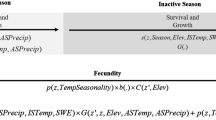Abstract
The population dynamics and distribution limits of plant species are predicted to change as the climate changes. However, it remains unclear to what extent climate variables affect population dynamics, which vital rates are most sensitive to climate change, and whether the same vital rates drive population dynamics in different populations. In this study, we used long-term demographic data from two populations of the terrestrial orchid Himantoglossum hircinum growing at the northern edge of their geographic range to quantify the influence of climate change on demographic vital rates. Integral projection models were constructed to study how climate conditions between 1991 and 2006 affected population dynamics and to assess how projected future climate change will affect the long-term viability of this species. Based on the parameterised vital rate functions and the observed climatic conditions, one of the studied populations had an average population growth rate above 1 (λ = 1.04), while the other was declining at ca. 3 % year−1 (λ = 0.97). Variation in temperature and precipitation mainly affected population growth through their effect on survival and fecundity. Based on UK Climate Projection 2009 estimates of future climate conditions for three greenhouse gas emission scenarios, population growth rates are expected to increase in one of the studied populations. Overall, our results indicate that the observed changes in climatic conditions appeared to be beneficial to the long-term survival of the species in the UK and suggest that they may have been the driving force behind the current range expansion of H. hircinum in England.





Similar content being viewed by others
References
Bale JS, Masters GJ, Hodkinson ID et al (2002) Herbivory in global climate change research: direct effects of rising temperature on insect herbivores. Glob Chang Biol 8:1–16. doi:10.1046/j.1365-2486.2002.00451.x
Bates DM, Mächler M, Bolker BM, Walker SC (2014) Fitting linear mixed-effects models using lme4. arXiv:1406.5823
Batty AL, Dixon KW, Brundrett M, Sivasithamparam K (2001) Constraints to symbiotic germination of terrestrial orchid seed in a mediterranean bushland. New Phytol 152:511–520. doi:10.1046/j.0028-646X.2001.00277.x
Bremer P, Jongejans E (2010) Frost and forest stand effects on the population dynamics of Asplenium scolopendrium. Popul Ecol 52:211–222. doi:10.1007/s10144-009-0143-7
Bucharová A, Brabec J, Münzbergová Z (2012) Effect of land use and climate change on the future fate of populations of an endemic species in Central Europe. Biol Conserv 145:39–47. doi:10.1016/j.biocon.2011.09.016
Burnham KP, Anderson DR (2002) Model selection and multi-model inference: a practical information-theoretic approach. Springer, New York
Bütof A, von Riedmatten LR, Dormann CF et al (2012) The responses of grassland plants to experimentally simulated climate change depend on land use and region. Glob Chang Biol 18:127–137. doi:10.1111/j.1365-2486.2011.02539.x
Carey PD (1999) Changes in the distribution and abundance of Himantoglossum hircinum (L.) Sprengel (Orchidaceae) over the last 100 years. Watsonia 22:353–364
Carey PD, Farrell L (2002) Biological flora of the British isles Himantoglossum hircicum (L.) Sprengel. J Ecol 90:206–218. doi:10.1046/j.0022-0477.2001.00640.x
Carey PD, Farrell L, Stewart NF (2002) The sudden increase in the abundance of Himantoglossum hircinum in England in the past decade and what has caused it. In: Kindlman P, Willems JH, Whigham DF (eds) Trends and fluctuations and underlying mechanisms in terrestrial orchid populations. Backhuys, Leiden, pp 187–208
Cheffings C, Farrell L (2005) The vascular plant red data list for Great Britain. http://jncc.defra.gov.uk/page–3354
Christierson BV, Vidal JP, Wade SD (2012) Using UKCP09 probabilistic climate information for UK water resource planning. J Hydrol 424–425:48–67. doi:10.1016/j.jhydrol.2011.12.020
Claessens J, Kleynen J (2011) The flower of the European orchid: form and function. Schrijen-Lippertz, Voerendaal
Crompton G, Farrell L (1985) Survey of Himantoglossum hircinum in Northern France, 1984. Internal report to the Nature Conservancy Council. Nature Conservancy Council, Peterborough
Dalgleish HJ, Koons DN, Hooten MB et al (2011) Climate influences the demography of three dominant sagebrush steppe plants. Ecology 92:75–85. doi:10.1890/10-0780.1
de Jong TJ, Goosen-de Roo L, Klinkhamer PGL (1998) Is the threshold size for flowering in Cynoglossum officinale fixed or dependent on environment? New Phytol 138:489–496. doi:10.1046/j.1469-8137.1998.00118.x
Doak DF, Morris WF (2010) Demographic compensation and tipping points in climate-induced range shifts. Nature 467:959–962. doi:10.1038/nature09439
Easterling MR, Ellner SP, Dixon PM (2000) Size-specific sensitivity: applying a new structured population model. Ecology 81:694–708. doi:10.1890/0012-9658(2000)081[0694:SSSAAN]2.0.CO;2
Ellner SP, Rees M (2006) Integral projection models for species with complex demography. Am Nat 167:410–428. doi:10.1086/499438
Franco M, Silvertown J (2004) A comparative demography of plants based upon elasticities of vital rates. Ecology 85:531–538. doi:10.1890/02-0651
Hickling R, Roy DB, Hill JK et al (2006) The distributions of a wide range of taxonomic groups are expanding polewards. Glob Chang Biol 12:450–455. doi:10.1111/j.1365-2486.2006.01116.x
Hunter CM, Caswell H, Runge MC et al (2010) Climate change threatens polar bear populations: a stochastic demographic analysis. Ecology 91:2883–2897. doi:10.1890/09-1641.1
Hutchings MJ (2010) The population biology of the early spider orchid Ophrys sphegodes Mill. III. Demography over three decades. J Ecol 98:867–878. doi:10.1111/j.1365-2745.2010.01661.x
Jacquemyn H, Brys R, Vandepitte K et al (2007) A spatially explicit analysis of seedling recruitment in the terrestrial orchid Orchis purpurea. New Phytol 176:448–459. doi:10.1111/j.1469-8137.2007.02179.x
Jacquemyn H, Brys R, Honnay O (2009) Large population sizes mitigate negative effects of variable weather conditions on fruit set in two spring woodland orchids. Biol Lett 5:495–498. doi:10.1098/rsbl.2009.0262
Jacquemyn H, Brys R, Jongejans E (2010) Size-dependent flowering and costs of reproduction affect population dynamics in a tuberous perennial woodland orchid. J Ecol 98:1204–1215. doi:10.1111/j.1365-2745.2010.01697.x
Jenouvrier S, Holland M, Stroeve J et al (2012) Effects of climate change on an emperor penguin population: analysis of coupled demographic and climate models. Glob Chang Biol 18:2756–2770. doi:10.1111/j.1365-2486.2012.02744.x
Kull T (1998) Fruit-set and recruitment in populations of Cypripedium calceolus L. in Estonia. Bot J Linn Soc 126:27–38. doi:10.1111/j.1095-8339.1998.tb02513.x
Levine JM, McEachern AK, Cowan C (2008) Rainfall effects on rare annual plants. J Ecol 96:795–806. doi:10.1111/j.1365-2745.2008.01375.x
Linderholm HW (2006) Growing season changes in the last century. Agric For Meteorol 137:1–14. doi:10.1016/j.agrformet.2006.03.006
Met Office (2013) UKCP09: gridded observation data sets. http://www.metoffice.gov.uk/climatechange/science/monitoring/ukcp09/
Metcalf CJE, McMahon SM, Salguero-Gómez R, Jongejans E (2013) IPMpack: an R package for integral projection models. Methods Ecol Evol 4:195–200. doi:10.1111/2041-210x.12001
Miller D, Morgan BJT, Ridout MS et al (2011) Methods for exact perturbation analysis. Methods Ecol Evol 2:283–288. doi:10.1111/j.2041-210X.2010.00074.x
Miller-Rushing AJ, Høye TT, Inouye DW, Post E (2010) The effects of phenological mismatches on demography. Philos Trans R Soc Lond B Biol Sci 365:3177–3186. doi:10.1098/rstb.2010.0148
Nicolè F, Dahlgren JP, Vivat A et al (2011) Interdependent effects of habitat quality and climate on population growth of an endangered plant. J Ecol 99:1211–1218. doi:10.1111/j.1365-2745.2011.01852.x
Øien D-I, Moen A (2002) Flowering and survival of Dactylorhiza lapponica and Gymnadenia conopsea in the Sølendet nature reserve, Central Norway. In: Kindlmann P, Willems JH, Whigham DF (eds) Trends and fluctuations and underlying mechanisms in terrestrial orchid populations. Backhuys, Leiden, pp 3–22
Ozgul A, Childs DZ, Oli MK et al (2010) Coupled dynamics of body mass and population growth in response to environmental change. Nature 466:482–485. doi:10.1038/nature09210
Parmesan C, Yohe G (2003) A globally coherent fingerprint of climate change impacts across natural systems. Nature 421:37–42. doi:10.1038/nature01286
Peñuelas J, Gordon C, Llorens L et al (2004) Nonintrusive field experiments show different plant responses to warming and drought among sites, seasons, and species in a north-south European gradient. Ecosystems 7:598–612. doi:10.1007/s10021-004-0179-7
Pereira HM, Leadley PW, Proença V et al (2010) Scenarios for global biodiversity in the 21st century. Science (80) 330:1496–1501. doi:10.1126/science.1196624
Perring FH, Farrell L (1977) British Red Data books. I. Vascular plants. Society for the Promotion of Nature Conservation, Lincoln
Pfeifer M, Wiegand K, Heinrich W, Jetschke G (2006) Long-term demographic fluctuations in an orchid species driven by weather: implications for conservation planning. J Appl Ecol 43:313–324. doi:10.1111/j.1365-2664.2006.01148.x
Pinheiro JC, Bates DM (2000) Mixed-effects models in S and S-plus. Springer, New York
Preston CD, Hill MO (1997) The geographical relationships of British and Irish vascular plants. Bot J Linn Soc 124:1–120. doi:10.1111/j.1095-8339.1997.tb01785.x
R Development Core Team (2015) R: a language and environment for statistical computing. http://www.r-project.org/
Rasmussen HN (1995) Himantoglossum. In: Rasmussen HN (ed) Terrestrial orchids: from seed to mycotrophic plant. Cambridge University Press, Cambridge, pp 327–328
Rees M, Ellner SP (2009) Integral projection models for populations in temporally varying environments. Ecol Monogr 79:575–594. doi:10.1890/08-1474.1
Riba M, Picó FX, Mayol M (2002) Effects of regional climate and small-scale habitat quality on performance in the relict species Ramonda myconi. J Veg Sci 13:259–268. doi:10.1111/j.1654-1103.2002.tb02046.x
Scott HS, Carey PD (2002) The effects of fungicide and water application on seed germination and infection in Gymnadenia conopsea under field conditions. In: Kindleman P, Willems JH, Whigham DF (eds) Trends and fluctuations and underlying mechanisms in terrestrial orchid populations. Backhuys, Leiden, pp 155–165
Simons AM, Goulet JM, Bellehumeur KF (2010) The effect of snow depth on overwinter survival in Lobelia inflata. Oikos 119:1685–1689. doi:10.1111/j.1600-0706.2010.18515.x
Sletvold N, Dahlgren JP, Øien D-I et al (2013) Climate warming alters effects of management on population viability of threatened species: results from a 30-year experimental study on a rare orchid. Glob Change Biol 19:2729–2738. doi:10.1111/gcb.12167
Stubben CJ, Milligan BG (2007) Estimating and analyzing demographic models using the popbio package in R. J Stat Softw 22
Sturm M, Racine C, Tape K (2001) Climate change: increasing shrub abundance in the Arctic. Nature 411:546–547. doi:10.1038/35079180
Tamm CO (1972) Survival and flowering of some perennial herbs. II. The behaviour of some orchids on permanent plots. Oikos 23:23–28. doi:10.2307/3543923
Thomas CD, Cameron A, Green RE et al (2004) Extinction risk from climate change. Nature 427:145–148. doi:10.1038/nature02121
van Mantgem PJ, Stephenson NL (2007) Apparent climatically induced increase of tree mortality rates in a temperate forest. Ecol Lett 10:909–916. doi:10.1111/j.1461-0248.2007.01080.x
Vindenes Y, Engen S, Sæther B-E (2011) Integral projection models for finite populations in a stochastic environment. Ecology 92:1146–1156. doi:10.1890/10-0500.1
Walther G, Post E, Convey P et al (2002) Ecological responses to recent climate change. Nature 416:389–395. doi:10.1038/416389a
Wells TCE (1967) Changes in a population of Spiranthes spiralis (L.) Chevall. at Knocking Hoe national nature reserve, Bedfordshire, 1962–65. J Ecol 55:83–99. doi:10.2307/2257718
Wells TCE (1981) Population ecology of terrestrial orchids. In: Synge H (ed) The biological aspects of rare plant conservation. Wiley, Chichester, pp 281–295
Williams JL, Jacquemyn H, Ochocki BM et al (2015) Life history evolution under climate change and its influence on the population dynamics of a long-lived plant. J Ecol 103:798–808. doi:10.1111/1365-2745.12369
Acknowledgments
The authors would like to thank the landowners where the study populations are located; their continued support is much appreciated. The study plots at Newmarket were recorded by Lynne Farrell and Gigi Crompton from 1977 to 1994 and the Sandwich population plots were created and recorded in 1987 by Nick Stewart who continued to record with P. Carey until 2003. Many volunteers have assisted with the recording of the plots over the years. The authors would also like to thank two reviewers who provided useful comments on an earlier draft of this paper. Recording of the plots was supported by various Natural Environment Research Council grants from 1991 to 2007 (P. C.). This work was also supported by the Flanders Research Foundation (project 11G1715N; S. M.), the European Research Council (starting grant 260601—MYCASOR; H. J.) and the Netherlands Organisation for Scientific Research (project 841.11.007; E. J.). The authors declare that they have no conflict of interest.
Author contribution statement
P. C., H. J. and E. J. formulated the idea; P. C. conducted the fieldwork; S. M. and E. J. constructed the models and analysed the data; and S. M., P. C., H. J. and E. J. wrote the manuscript.
Author information
Authors and Affiliations
Corresponding author
Additional information
Communicated by Jennifer A. Lau.
Electronic supplementary material
Below is the link to the electronic supplementary material.
442_2016_3592_MOESM3_ESM.xlsx
Online resource 3 Table with statistical details of the weather-dependent vital rate functions, showing all 256 models from the weighted averaging procedure with corresponding Akaike information criterion scores and weights
442_2016_3592_MOESM4_ESM.pdf
Online resource 4 Analysis that reveals which vital rates contributed most to the variation in population growth rates of populations Newmarket and Sandwich. Including a description of our method, results and a graph showing the effect of integrating vital rate functions of one population into the integral projection model of the other population, on the projected population growth rate
442_2016_3592_MOESM5_ESM.pdf
Online resource 5 Figure showing the observed population structure of Himantoglossum hircinum in populations Newmarket and Sandwich between 1991 and 2006
442_2016_3592_MOESM6_ESM.pdf
Online resource 6 Relationship between population growth and mean annual temperature and mean annual precipitation in populations Newmarket and Sandwich
442_2016_3592_MOESM7_ESM.pdf
Online resource 7 Table and figure showing the effect of a combination of climate variables (principal component 1; PC1) on the projected population growth rate
442_2016_3592_MOESM8_ESM.pdf
Online resource 8 Figure showing projected future changes in temperature and precipitation in populations Newmarket and Sandwich under a low, medium and high greenhouse gas emission scenario
442_2016_3592_MOESM9_ESM.pdf
Online resource 9 Table with all standardized climate conditions in populations Newmarket and Sandwich between 1991 and 2006
442_2016_3592_MOESM10_ESM.pdf
Online resource 10 Figure showing seasonal temperature and precipitation between 1991 and 2006 in populations Newmarket and Sandwich
Rights and permissions
About this article
Cite this article
van der Meer, S., Jacquemyn, H., Carey, P.D. et al. Recent range expansion of a terrestrial orchid corresponds with climate-driven variation in its population dynamics. Oecologia 181, 435–448 (2016). https://doi.org/10.1007/s00442-016-3592-7
Received:
Accepted:
Published:
Issue Date:
DOI: https://doi.org/10.1007/s00442-016-3592-7




